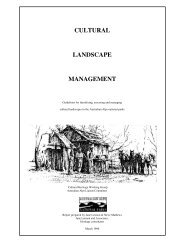Proceedings of an International Year of Mountains - Australian Alps ...
Proceedings of an International Year of Mountains - Australian Alps ...
Proceedings of an International Year of Mountains - Australian Alps ...
Create successful ePaper yourself
Turn your PDF publications into a flip-book with our unique Google optimized e-Paper software.
Price<br />
12<br />
11<br />
Consumer<br />
surplus<br />
attributable<br />
to the first<br />
glass <strong>of</strong><br />
water<br />
Consumer<br />
surplus<br />
attributabl<br />
able to<br />
the second glass<br />
<strong>of</strong> water<br />
Consumer<br />
surplus <br />
attributabl<br />
able to<br />
the third glass <strong>of</strong><br />
water<br />
10<br />
9<br />
8<br />
7<br />
6<br />
5<br />
4<br />
3<br />
2<br />
P = 1<br />
0<br />
Total consumer surplus<br />
from consuming ten<br />
glasses <strong>of</strong> water<br />
Dem<strong>an</strong>d Curve<br />
0 1 2 3 4 5 6 7 8 9 10 11 12<br />
Qu<strong>an</strong>tity<br />
Figure 3 - Consumer Surplus<br />
Consumer Surplus <strong>an</strong>d The TCM<br />
While there are m<strong>an</strong>y different versions <strong>of</strong> the TCM, the simplest (hereafter referred to as the zonal TCM)<br />
is theoretically capable <strong>of</strong> generating <strong>an</strong> estimate <strong>of</strong> the consumer surplus (CS) attributable to recreation<br />
at a particular area.<br />
TCM treats the cost <strong>of</strong> travel as a proxy for price. The first stage <strong>of</strong> the TCM involves identifying the<br />
number <strong>an</strong>d origin <strong>of</strong> visitors to a recreational site, <strong>an</strong>d estimating their costs in travelling from that origin<br />
to the site <strong>an</strong>d back again. This information is then used to estimate the functional relationship between<br />
visitation rates <strong>an</strong>d travel costs. Stage two <strong>of</strong> the process makes the assumption that individuals react to<br />
ch<strong>an</strong>ges in travel costs in the same way as they react to ch<strong>an</strong>ges in price, <strong>an</strong>d uses the function estimated<br />
in stage one to simulate visitation responses to hypothetical ch<strong>an</strong>ges in price. A dem<strong>an</strong>d curve for the<br />
recreational area is thereby derived <strong>an</strong>d used to estimate consumer surplus.<br />
To illustrate, assume that travel costs, alone, influence visitation, that the current entry price (P) is zero.<br />
Assume also that the research observes the number <strong>of</strong> visits (V) from each <strong>of</strong> three different ‘zones <strong>of</strong><br />
origin’, at a r<strong>an</strong>ge <strong>of</strong> different travel costs (TC). These are shown in the first three columns <strong>of</strong> Table 1.<br />
Stage one <strong>of</strong> the implementation process involves regressing V against TC to estimate wV/wTC (in this<br />
case, negative 1). From this, one c<strong>an</strong> infer that within <strong>an</strong>y zone, 'V = -1 x 'TC. Stage two <strong>of</strong> the<br />
implementation process occurs when one uses that information to predict the number <strong>of</strong> visits (from each<br />
zone) which would obtain at higher travel costs (= TC + P):<br />
150<br />
Celebrating <strong>Mountains</strong> – An <strong>International</strong> <strong>Year</strong> <strong>of</strong> <strong>Mountains</strong> Conference<br />
Jindabyne, New South Wales, Australia

















